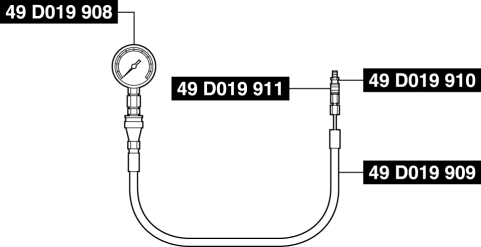Mazda CX-5 Service & Repair Manual: Oil Pressure Inspection
WARNING:
-
Hot engines and engine oil can cause severe burns. Turn off the engine and wait until it and the engine oil have cooled.
-
A vehicle that is lifted but not securely supported on safety stands is dangerous. It can slip or fall, causing death or serious injury. Never work around or under a lifted vehicle if it is not securely supported on safety stands.
-
Continuous exposure to USED engine oil has caused skin cancer in laboratory mice. Protect your skin by washing with soap and water immediately after working with engine oil.
1. Disconnect the negative battery cable..
2. Remove the front under cover No.2..
3. Remove the oil pressure switch..
NOTE:
-
Use the following SSTs in this inspection.

-
49 D019 908 (gauge)
-
49 D019 909 (hose)
-
49 D019 910 (adapter)
-
49 D019 911 (adapter)
4. Install the SSTs
to the oil pressure switch installation hole using the following procedure.
a. Assemble SSTs 49 D019 908
, 49 D019 909
, and 49 D019 911
outside of the engine compartment beforehand.
b. Install SST 49 D019 910
to the oil pressure switch installation hole.
c. Install SST 49 D019 911
to the SST 49 D019 910
.
5. Connect the negative battery cable..
6. Warm up the engine to normal operating temperature.
7. Run the engine at the specified speed, and note the gauge readings.
-
If not within the specification, inspect for the cause and repair or replace if necessary.
NOTE:
-
The oil pressure can vary with oil viscosity, temperature and engine speed.
-
Oil pressure (reference value) [coolant temperature: 80—90 °C {176—194 °F}]
-
Lo : 110—175 kPa {1.13—1.78 kgf/cm2, 16.0—25.3 psi} [1,500 rpm]
-
Hi : 300—430 kPa {3.06—4.38 kgf/cm2, 43.6—62.3 psi} [4,500 rpm]
8. Stop the engine and wait until it is cools.
9. Disconnect the negative battery cable..
10. Remove the SSTs.
11. Install the oil pressure switch..
12. Connect the negative battery cable..
13. Start the engine and confirm that there is no oil leakage.
-
If there is oil leakage, repair or replace the applicable part.
14. Install the front under cover No.2..
 Oil Pan
Oil Pan
Purpose, Function
The engine oil required for lubrication in the engine accumulates in the
oil pan.
Construction
The oil pan is installed on the lower part of the cylinder block ...
 Oil Pump Removal/Installation
Oil Pump Removal/Installation
WARNING:
Hot engines and engine oil can cause severe burns. Turn off the engine and
wait until it and the engine oil have cooled.
A vehicle that is lifted but not securely supported ...
Other materials:
Automatic Transaxle Shift Mechanism [Fw6 A EL, Fw6 Ax EL]
Outline
A sport AT-type shift mechanism has been adopted for all models.
An electric shift-lock system has been adopted to prevent driver mis-operation.
A manual shift-lock release system has been adopted to ensure emergency bypass
if shifting operations cannot be performed ...
Electronic Control Coupling
Purpose, Function
An electromagnetic clutch, which operates smoothly due to the lack influence
from the front and rear wheel traction force, has been adopted for the electronic
control coupling system.
Construction
The construction of the coupling enables the torque formed ...
Engine Oil Solenoid Valve Inspection
Engine Oil Solenoid Valve Operation Inspection
1. Remove the engine oil solenoid valve..
2. Verify that the battery is fully charged.
3. Connect the battery to the engine oil solenoid valve connector (2 terminals)
as shown in the figure.
4. Verify that there is an operation sound from t ...
